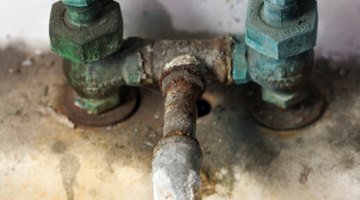How to Loosen a Corroded Faucet
Corrosion occurs when a metal reacts with its environment and results in deterioration of the metal. Around a faucet, the most common cause of corrosion is rust. Rust is caused by the metal reacting with the oxygen in the air.

Corrosion on the faucet can make it difficult to remove when trying to replace or repair the sink. The corrosion around the faucet can easily be loosened so you can remove the faucet and address any problems.
-
Turn off the water valve at a main line. This step prevents water from accidentally leaking or spraying while you are working with the corroded faucet.
-
Apply the penetrating oil on the corroded portion of the faucet, especially around the area where the faucet attaches, so it can be removed to repair or replace. Allow the oil to rest on the corroded area for a minute.
-
Loosen the faucet using your hands or a wrench. If the faucet still will not loosen up, try tapping it gently with a hammer around the corroded area. This may help to break up corrosion so the faucet can be removed.
-
Place more of the penetrating oil in a bag and allow the corroded faucet to soak in it over night if the faucet will still not loosen up. This may need to be repeated two times to loosen the corrosion.
-
Wipe the penetrating oil off using a cloth.
Things You Will Need
- Penetrating oil (such as WD-40 or equivalent)
- Hammer
- Cloths
- Wrench
- Plastic bag
Tip
Applying heat with a hair blow dryer may also help to loosen up the corrosion. If you don't have WD-40 available, try using soda, hydrogen peroxide or transmission fluid to soak the corroded area.
Warning
Wash hands well after handling penetrating oil or any chemicals.
References
Writer Bio
Reese Armstrong graduated from Kent State University in 2007 with a Bachelor of Arts in biology. Armstrong has been writing professionally since 2010 and published articles on various websites. For several years she worked as a skin care consultant for a major cosmetic company.
Photo Credits
- Jupiterimages/Comstock/Getty Images
- Jupiterimages/Comstock/Getty Images
More Articles



